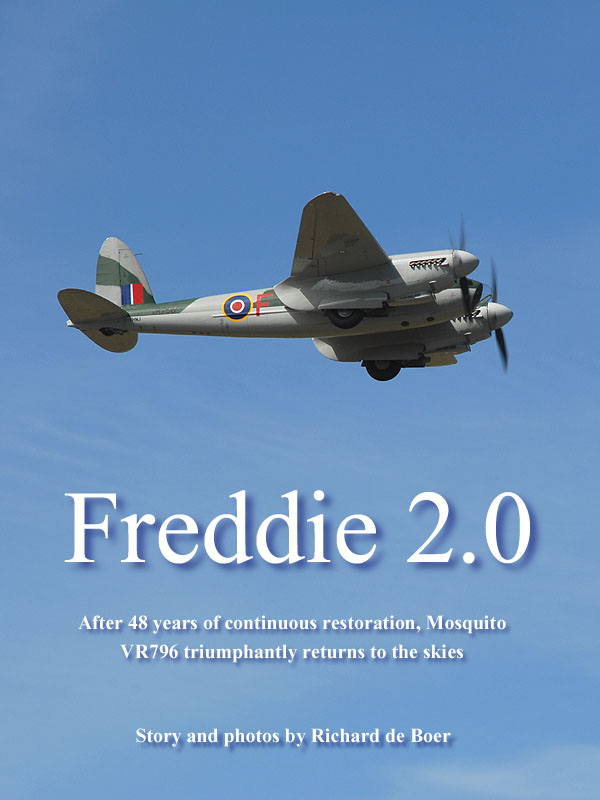

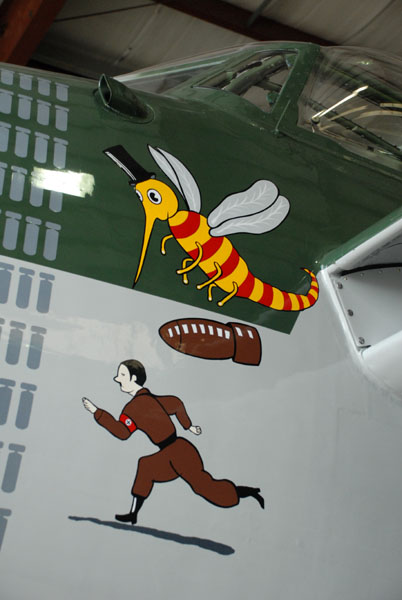
The distinctive and colourful nose art of F for Freddie reproduced on Mosquito VR 796.
(Richard de Boer)
At noon on Monday, June 16, 2014 a sister ship to ours, Mosquito VR796, took to the air in Victoria, BC for the first time since June 1963. Sometimes referred to as the world's longest
continuous aircraft restoration, this Mosquito had been under rebuild since it was acquired by Don Campbell from Spartan Air Services in 1966.
Like ours, this Mosquito started life in the Airspeed factory in England after the war and was built as a B.35 model. Serialed VR796, it too went into storage, but unlike ours it was not
converted to photo recon standards and did not serve in the RAF. It became a true sister ship to ours when it was purchased by Spartan Air Services in 1954 as one of 15 Mosquitoes (10
were flown, one of which was grounded as soon as it got to Ottawa, and 5 were used for parts) acquired for high altitude photo mapping work in Canada and abroad. It acquired Canadian
registration CF-HML and was the first of the Spartan Mosquitoes to be ferried across the Atlantic, arriving at the Uplands Airport on May 3, 1955. HML soon went to work carrying Wild RC5
and RC8 cameras throughout northern and western Canada for its photo mapping missions.
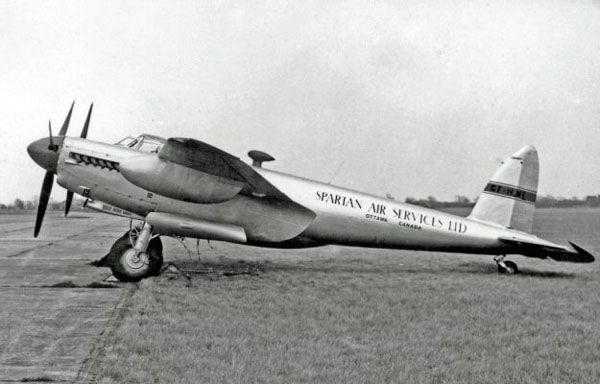
CF-HML as she appeared April 23, 1955, fresh out of maintenance at Derby Aviation.
(R.A.Scholefield via Air Britain)
It made its last flight for Spartan when it was ferried from Thunder Bay to Ottawa in 1963. At that point it had a total of just 515 hours and 10 minutes flying time. Its road back into
the air was long, twisted and uncertain.
In 1966 Don Campbell purchased HML from Spartan and brought her home to Kapuskasing, ON where he and the Air Cadets of No. 647 Squadron began work on her. In 1979 Don made a deal with Mike
Meeker, owner of Anglo-American Cedar Products of Mission, BC for the Mosquito to be transported to BC for completion. Some time prior to this Meeker had acquired the remains of the famous
Mexico City, Holiday Inn Mosquito, a B.35 registered HB-TOX. HML was placed in an inconspicuous building in Matsqui, BC, just north of Abbotsford. The Canadian Museum of Flight and
Transportation headed by Ed and Rose Zalesky also acquired an interest in the airplane and in the lean economic days of the early 1980s the federal government put some job creation money
toward the restoration project as it helped to employ newly graduated aircraft engineers.
Eventually full ownership passed to Bob Jens of Vancouver in the early 1990s and HML was moved to the Vancouver Airport where engineers from Jens' aviation business worked on the Mosquito.
In 2009 Jens made the decision to contract out the completion of HML to Victoria Air Maintenance at the Sidney, BC airport. Five years later, she was readied for her first flight.
I first saw her in September 2011 when I was invited to be the inaugural speaker at the new Victoria chapter of the Canadian Aviation Historical Society. At the time rumours were circulating
that the owner was going to finish his Mosquito as the wartime 'F for Freddie'. I naturally chose that as the topic for my presentation.
If you have hung around me for more than ten minutes you likely know of my mostly harmless obsession with the story of F for Freddie. The original Freddie was a B.IX Mosquito which over the
course of World War II accumulated 213 combat ops; more than any other Allied bomber aircraft of the war. It crashed, killing its crew, in Calgary two days after VE Day. You can read an
online version by following this link.
Mel Johnstone, lead engineer on the restoration of HML, attended the presentation and invited me out to see the airplane the next day. I wasn't quite sure of the reception I would get at
Victoria Air Maintenance (VAM) as they too had put in a bid to restore the Calgary Mosquito once the City had committed to keeping and restoring it. I needn't have worried. I met VAM's
owner Mike Ingram and he congratulated us on winning the long campaign to keep and restore HMS.
Their Mosquito was in the paint shop getting a series of coats of silver dope before being painted. Mel showed me around and apologized that there wasn't much to see as it was largely
masked off for painting. He told me how they had bent all new tubing throughout the bomb bay for the hydraulic systems and about the great look of the fully restored and functional cockpit.
Mel paused for a moment, said something under his breath and started ripping away the yards and yards of paper and masking tape from the cockpit door and bomb bay so that I could see their
beautiful work. It was clear that this was more than a job to him.

VR796 as she appeared in the paint shop at Victoria Air Maintenance during a visit in September 2011.
(Richard de Boer)
The next year the paint and markings started to go on and the rumours that HML was to be painted in tribute to the original F for Freddie were true. The finished product caused some dismay
among the purists for its glossy finish. As well, it was decided not to use the original F for Freddie's serial number on the rear fuselage, but to retain the original serial number of this
particular airplane.
In April of this year the internet jungle drums were busy spreading the word of HMJ's first engine runs. Yes, that's right; HML was now HMJ. Jens had tried to acquire the original
registration, but it was now on a Rockwell Commander in Quebec and a deal could not be made to reacquire it. Mike Nixon, owner of Merlin engine specialty shop Vintage V-12s came up to VAM
to personally start the newly installed 113 and 114 model Merlins. They hummed, purred and roared, as only Merlins can. VAM posted great videos of the engine starts from both inside and
outside the Mosquito on their Facebook page. Scroll down to the bottom of the page for a look.
'When's it going to fly?' 'When's it going to fly?' was the hot question on the lips of warbird fans around the world. VAM was in a difficult position: They weren't supposed to say. The
Mosquito's owner wanted no publicity or attention given to its first, or subsequent, flights.
I heard that the flight was scheduled for early May and made my plans to drive out. How could I not take the chance? It was a former Spartan machine, a sister to ours and it was now
painted as Freddie. I had to.
I arrived on May 6 and made my way into VAM's hangar. I soon discovered that a first flight is not a single event, but is rather a series of events. I knew that the original F for Freddie
had crashed that very week, 69 years earlier. Yet in their hangar I had my first look at this new and somewhat ghostly version of Freddie. I've been chasing this story since I was 17 years
old. Emotions clashed as I saw the famous nose art and I turned away from others in the hangar to hide my tears. I circled it, took some pictures and finally touched it - just to be sure.
In short order Mel Johnstone entered the hangar just having picked up the pilot who was contracted to fly the Mosquito. The pilot introduced himself, walked around the airplane and then
stopped near the nose, pulling out his iPhone to take a 'selfie' with his wife, using the distinctive nose art of F for Freddie as the background.
Back when I wore a younger man's clothes, there was a pilot whom I admired a great deal. He wasn't a lot older than me, but his accomplishments were amazing. By age 29 he had won the
unlimited class at the Reno National Air Races and set an all time speed record for propeller driven aircraft that stood for 10 years. He flew for a lot of movies and got into the museum
and restoration business as well. In 1979, while air racing in a Griffon powered 500 mph monster at an altitude of 40 feet, his airplane suffered a catastrophic engine failure. He was too
far from the runway and had nothing but desert boulders in front of him.
In the seconds before impact, he radioed to his best friend. "Ain't gonna make it John. Tell Karen I love her".
I remember with frozen clarity hearing and watching it on ABC's old Wide World of Sports, back in the day. Being a romantic, it left quite an impression. Two seconds later there was a yellow
and black fireball. Karen was John's sister and the pilot's fiance.
The pilot emerged from the hospital a few months later having overcome a broken ankle, leg and back and continued on his path of amazing work in the old airplane business.
Being about the best in the business, he was hired to do the first flight in this Mosquito. As the pilot, Steve Hinton, called his wife Karen over to take their impromptu self portrait in
front of F for Freddie, I experienced one of the most surreal moment of my life.

Karen and Steve Hinton snap their own 'selfie' with Freddie 2.0.
(Richard de Boer)
I had a chance to ask Mel about the choice to hire Hinton for the test flights. "As much as he is one of the best pilots in the world, he's an even better engineer" Mel told me. That's
saying a bunch and a half.
It turned out to be a week of wonder and frustration. I met Mosquito veterans and people who have been writing letters on behalf of the Calgary Mosquito Society from the day we got started.
I met Mark Mohan who worked on HML as a newly minted apprenticing aircraft engineer when she came to BC in the early '80s. He is now working in Hong Kong and made the trip back specifically
to see her fly 30 years later. I met April Butler of Pan Productions who has been working on a documentary film of the restoration since it arrived in Victoria. I had lunch with Robert
Stitt, unofficial Spartan historian, who is now working on a book about this enterprising Canadian company after being inspired by our efforts to restore HMS to her Spartan glory days.
We hung around the hangar most of the next day as Mel, Hinton and the crew conducted gear swings, fixed position lights and made other adjustments. Both wheels would go up but then one would
fall down. Then one would go part way up and stop. Tweak and adjust was the theme for that day and the next.
As VAM owner Mike Ingram hooked up a tug to tow the Mosquito outside, I realized that I had never seen one outside; I'd only ever seen them in hangars and museums. I started to shift my
thinking on Mosquitoes. This one was alive in a way that no other Mosquito I had ever seen had been and she would soon fly. She looked beautiful in the sun.

Mike Ingram of VAM towing the Mosquito outside for engine runs.
(Richard de Boer)
Soon came the first engine start. It truly was alive. Both engines started before the props completed one revolution. Here was a Mosquito outside, making serious engine noises. Wow.
After a few starts and modest runs, it was towed back into the hangar for RPM adjustments on the props.
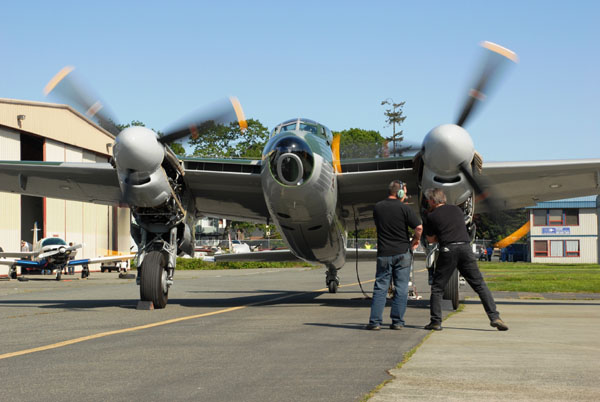
Two turning and burning - my first experience of a Mosquito coming to life!
(Richard de Boer)
The next day a barrier went up inside the street side hangar door to cut down on the number of tourists in the building. VAM had a business to run didn't need the hazards and distractions
that came with a herd of gawkers, no matter how devoted they might be.
After further runs and adjustments it was decided to take the airplane out to the main ramp for high power engine runs. I saw a Mosquito taxi under its own power for the first time. Robert
Stitt carried his portable air radio with him and turned it up loud. "I just want to hear them call ground control, identifying themselves as 'Mosquito, Charlie Fox Hotel...etc'" he said.
"Been a long time since those words have been heard over the radio." I leaned in to listen.
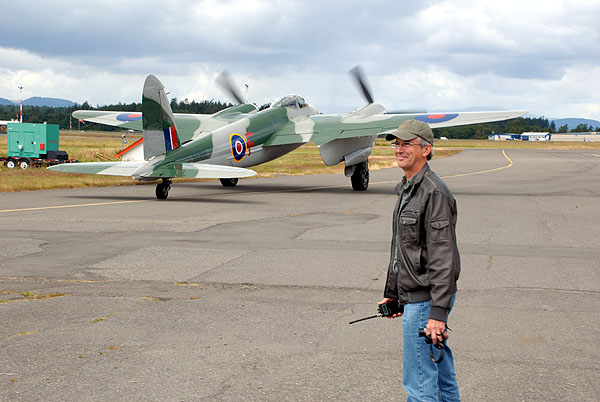
The smile says it all. Author and Spartan historian Robert Stitt enjoys the moment as VR796 taxis away for an engine run. (Richard de Boer)
They taxied past Viking Air where new DH Twin Otters are being made. 'Watch and listen kids; this is how an old school DH twin looks and sounds.'
Hinton taxied up to the end of the apron and back again, pointing her tail into the weeds. And then she roared. He took the Merlins to near full power. Even several hundred feet away, the
noise and vibration were all consuming. Viking staff came running out of the hangar and stopped in their tracks. We could barely speak to each other over the noise. We were transfixed and
possessed by the noise and the power. We could see her hopping forward as the power overwhelmed the brakes. The horizontal stabilizer flapped and shook in the wake of both props at full
power. 'Could you imagine a whole squadron?' we asked each other. We grinned. We stared. We shook our heads at each other. What was there to say? It was nothing but awesome.
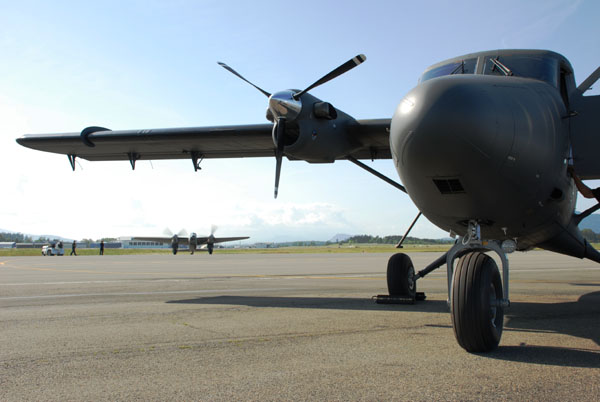
DH twins, a generation apart, sharing the ramp. While Viking's Twin Otters are assembled in Calgary and Victoria, the originals were built in the same Downsview factory as the Mosquito. (Richard de Boer)
They taxied back to VAM and shut down. There was more talk and more tweaking. It was decided to start her again to test the adjustments. Both were running at moderate power levels when
Mike Ingram came over and told them to shut it down. He could just see something happening on the starboard engine. The starter had refused to disengage and had burned out. Right away
Hinton got on the phone to his people in Chino, CA to arrange for a new starter to be shipped up by FedEx.
It was now May the 8th; the 69th anniversary of VE Day. The original Freddie had arrived in Calgary on May 9th and crashed on the 10th. I thought it best to not share the timing of events
with anyone there.
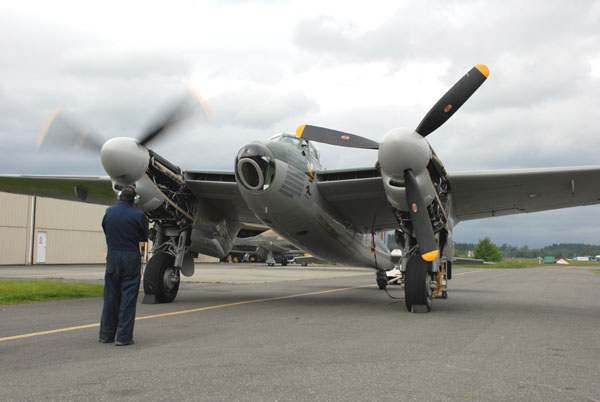
Looking eerily like May 9th, 1945 with dark clouds, cowlings removed and an engineer standing in front of her. (Richard de Boer)
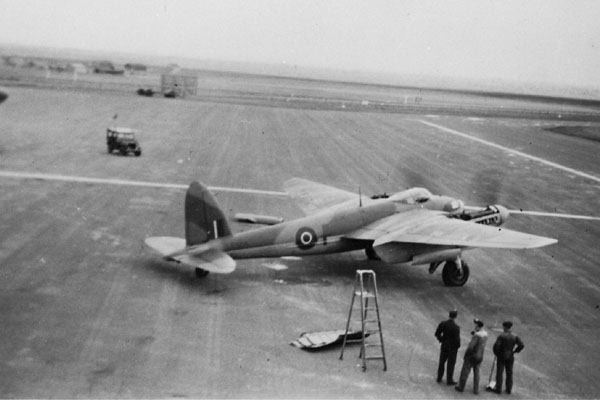
The original F for Freddie on the ramp in Calgary, May 9, 1945. (Richard de Boer)
The next morning it was essential staff only on deck. The viewers had either had enough or figured it wasn't going to happen. Mid morning we were told that the truck carrying the starter
to the airport in California had broken down. Okay, time for Plan B. Hinton had to get back to California by Saturday and the starter wouldn't arrive until Monday. He was next available
on May 26th so that was settled on for the next attempt. Just as everyone nodded in agreement, the girl from the office came in with news that in fact the starter had made it to Victoria
but that truck carrying it here, not in California, had broken down. It might arrive by mid afternoon. Mel took the lead and squashed any notion of trying to fly that day. 'Let's not rush
it. We have a plan. Let's stick with it.' Everyone agreed and we said our farewells, planning to reconvene on the 26th.
When I got home I decided not to try and drive back, so I booked a flight to return to Victoria on the 26th. The week prior to that I got an email from Mel asking me to call him. Their
undercarriage selector valve had failed. Did we have one and could they borrow it? I consulted with a couple of our board members and we agreed to ship it the next day. That night I had a
phone call from the Mosquito owner's right hand man on the project. They were very grateful. A piece of our Mosquito would fly with its sister ship HMJ.
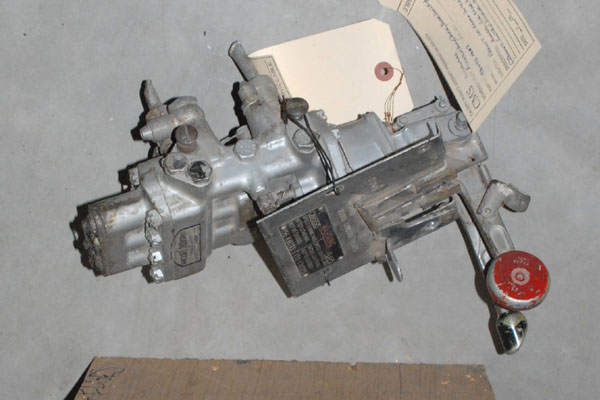
Our bomb door, undercarriage and flap selector valve before being shipped to Victoria Air Maintenace. (Richard de Boer)
Plans to fly on the 26th got postponed because of the new issues. Our valve was shipped to a hydraulic shop in Sidney where the seals were changed and the unit tested. It passed. A new
date was set for June 16.
I flew in that morning and again made my way to Victoria Air Maintenance's hangar. I didn't get 10 feet in the door when I heard staff grumbling about 'the circus being back' and 'damned
tourists'. That was my first indication that things were more than a little tense in the hangar. There was now a list of approved visitors. Everyone had to report in and if you weren't on
the list, you didn't get in. It was a very short list, but as film maker April Butler remarked, I had 'valve privileges.' It was enough to get me in the door, but I kept out of the way.
The rest of the faithful were gathered outside the fence.
By late morning the Mosquito was outside the hangar. A fuel truck pulled up. She really is alive in ways I had never known any other Mosquito to be. The owner had flown over from
Vancouver. He stood mostly by himself quietly watching. Hinton was in his tan flight suit with a life vest over top. Mel was going to be in the right seat. He called the tower for
clearance on his cell and they climbed in. Again both engines started with no more than two blades going past the cockpit.
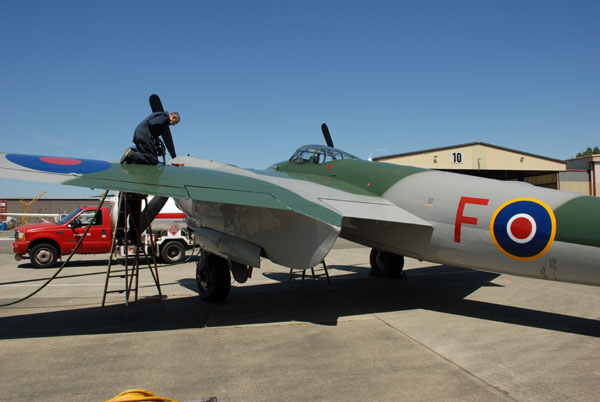
Engineer Mel Johnstone fueling up prior to her first flight. Memories of the Gimli Glider came to mind when Steve started asking about converting litres to gallons (US or Imperial?). (Richard de Boer)
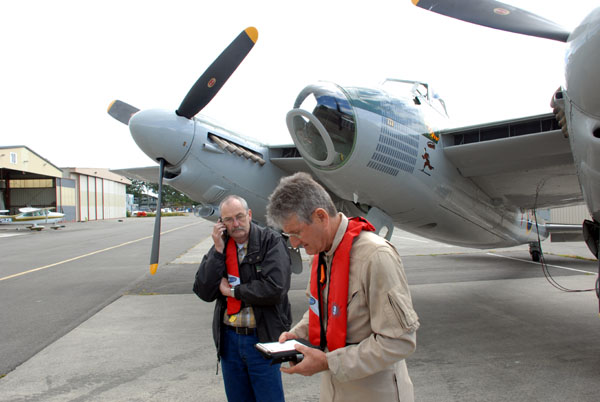
As Steve checks the flight plan, Mel calls for ATC clearance and checking the numbers prior to the first takeoff on June 16. (Richard de Boer)
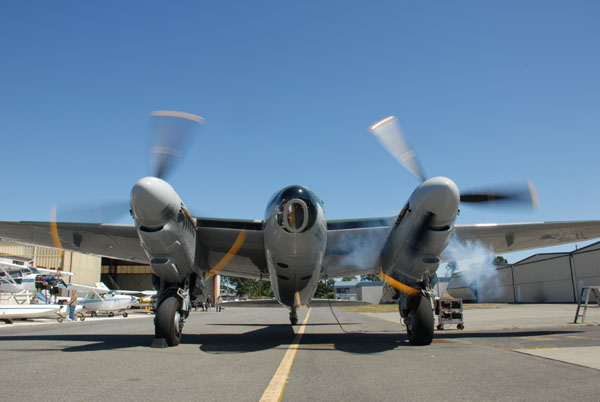
Firing up for her first test flight, a beauty comes to life.
(Richard de Boer)
Just three of us followed on foot, past Viking and up the ramp past the control tower and up to the Victoria Flying Club which sits near the end of runway 09. A small group of 30 or so
had also gathered in the grass adjacent to the runway. It's a little different than being at the Calgary airport. Not one person was wearing a red security pass. In Calgary you wouldn't
get 10 feet outside a building without one if you were on airside. Finally a commissionaire came by and politely asked people to move off the grass which abutted the runway.
The Mosquito taxied to the end of the 7000 foot runway and paused for a run through the checklist. They were going to take off straight towards us. I pointed my camera to where they sat
almost two kilometers away. With the wind at our backs you couldn't hear the power come up, but soon you could see them starting to move.
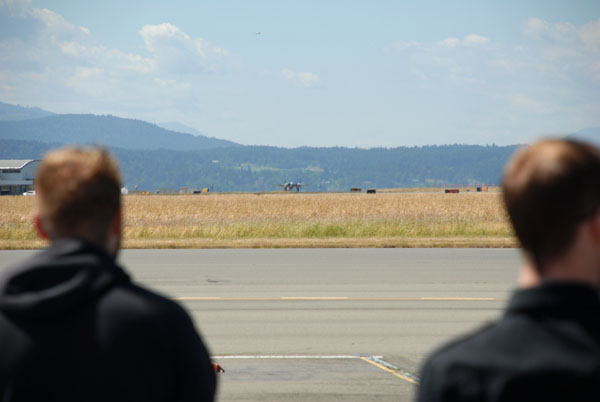
Rolling on Runway 09 for her first flight since 1963.
(Richard de Boer)
I actually missed the take off. I pointed my camera, clicked and tracked and clicked and tracked and focused on composition and bracketing exposures and before I knew it they were past us
and gone.
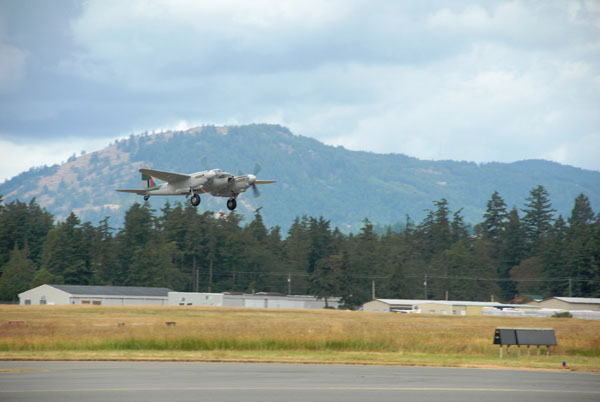
Liftoff! With port undercarriage just beginning to retract. Unfortunately it didn't.
(Richard de Boer)
It's one of the frustrating conundrums about being a picture taker: you can either experience the event or you can take pictures of it, but you can't be present for both at the same time.
I was so busy photographing it, that I didn't actually experience the take off. I didn't really hear it and I had no emotional reaction to seeing my first ever flight by a Mosquito and it
being Freddie to boot.
I did notice however that the port main gear was still hanging down below the airplane as they flew well past the airport perimeter. It didn't go up. The airplane climbed to 2500 ft and
made a single extended circuit of the airport. Robert Stitt was beside me, again with his air radio. We could hear Mel talking to the tower. As the man who did the gear swings and signed
her off, a lot was riding on his shoulders and you could hear every ounce of that weight in his voice. Someone else wondered how big the blast zone was around him was at that moment.
Thankfully the starboard gear came down and both locked. They were in the air for just 10 minutes. As they taxied past us on the way back to the hangar I wondered if it was our selector
valve that was at cause.
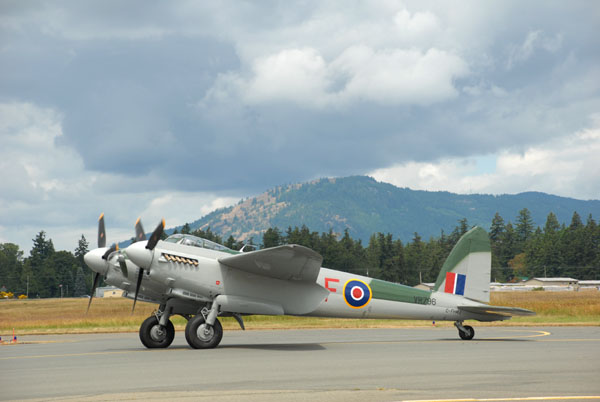
Taxiing back after the shortened first flight. There might have been problems with the main landing gear but as Steve quipped "Hey, the wings worked!" (Richard de Boer)
When we got back to the hangar, the first thing I heard Hinton say was "Well the wings worked" and "She doesn't fly sideways too well" in reference to the rather significant port side
drag. He also mentioned that a tachometer had failed on final and that there were differing oil pressures on the engines.
It was obvious that nothing else was going to happen that day as the airplane had to go back on the jacks for more gear swings, a new tach cable and more tweaking.
The next morning the gear issues were declared resolved and a new tach cable had been acquired and installed. Again the fuel truck came by to top up the tanks. I couldn't help but think of
the infamous Gimli Glider when Hinton asked how many litres there were to a gallon and someone else asked if he meant US or Imperial...

Fuelling up for day two. Steve again studies the numbers prior to takeoff. Having flown WW2-vintage airplanes since he was a teenager, Steve arguably the most experienced warbird pilots today and his no nonsense approach to the test flights was apparent. (Richard de Boer)
I crouched just 10 feet in front of the nose of the Mosquito to photograph the start of both engines. A puff of smoke out both sides and she was growling. Again I followed the airplane as
it taxied down the apron and then to the threshold of 09. This time I caught the torque roll on takeoff.

The infamous torque roll on takeoff; a disturbing sight and a phenomenon that took the life of too many Mosquito crews during the war. (Richard de Boer)
As sweet as its reputation is, the Mosquito has two deadly characteristic and both happen on takeoff. Not turning in opposite directions, the engines and props develop a huge amount of
torque all in one direction and the Mosquito's rudder is not big enough to hold it straight on the runway. The wartime pilot's notes even warn the unwary to watch for it. The standard
response is to use full opposite rudder and when even that doesn't keep her straight, you are to pull the power back on the starboard engine. Just as she was about to break from the runway,
the port wing tip dipped toward the ground as the opposite tip rose too quickly. 'He's missed correcting for it' I thought, but before I could finish the thought, Hinton had leveled the
wings and avoided catching a wing tip in the dirt. That night when I reviewed my photos of the first take off the day before, I could see exactly the same torque roll on takeoff. I
witnessed it again the next day on both takeoffs. It's an unsettling sight.
This time as she roared past us, both wheels retracted at the same time, dropped for a moment and then tucked up into the nacelles and stayed put. An hour later the pilot was honest enough
to admit that the gear drop was finger and not hydraulic trouble.
This time they orbited the field and headed south toward Victoria. After 45 minutes they returned and before landing, made a single pass at a modest speed and altitude, straight down the
runway. The landing was clean and smooth and in a minute they taxied right past us and back to the hangar.
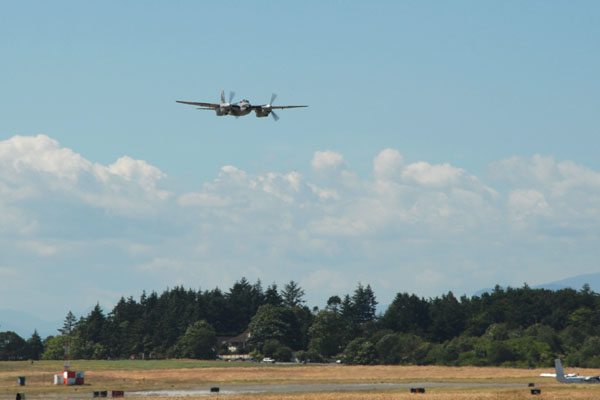
Inside or outside the fence, spectators and participants were treated to a modest flyby down the runway to cap off a successful flight. (Richard de Boer)
The atmosphere around the airplane and in the hangar was much lighter than it had been the day before. No gear problems, no starter problems and she behaved and flew well. Both Hinton and
Mel commented on how loud it was, even with modern helmets and headphones. They had kept the speed between 190 and 220 kts and had kept an eye on temperatures and pressures throughout the
flight. No tweaking required this time.
As gruff as VAM owner Mike Ingram can appear, I learned that his heart is in the right place. He hooked up the tug to the tail of the Mosquito, but instead of pulling it back into the
hangar, he drove forward pushing it toward the fence at the far end of the row of hangars. I had hopped onto the tug thinking to catch a photo from that perspective. In response to my
raised eyebrow Mike said 'These people on the other side of the fence have been there all day. I can't invite them in, but they deserve a chance to get a good picture.' It was a touching
end to a successful flying day.

VAM owner Mike Ingram pushes Freddie 2.0 out for some pictures, a wonderful gesture for the devoted Mosquito fans who spent the day (or days) watching the process from outside the fence. (Richard de Boer)
The next day two flights were planned, each with a T-28 chase plane in attendance. The purpose was to get some aerial footage for the documentary film. For the first of the two flights, a
GoPro camera was mounted in the T-28 cockpit as the airplane owners took advantage of the chance to fly in formation with the Mosquito.
We knew the routine by now. Fuel. Mel in the right seat. Taxi. Walk the considerable distance to the Victoria Flying Club for takeoff and revel in the rarity of the opportunity. Track
and click with the camera. There was the torque roll again. Away they went; gear securely where it was supposed to be. The T-28 developed radio problems and didn't join up for the morning
flight. Documentary producer April Butler and I had lunch on the patio of the Flying Club and were treated to a Mosquito fly by. It's a good life.

Flight #3 and the main landing gear are doing what they're supposed to do after takeoff.
(Richard de Boer)
For the second flight late in the afternoon, Mel gave up his seat to John Watt. John is a retired airline pilot who had the privilege of flying Mosquito G-MOSI from England to Dayton, OH for
the US Air Force Museum in 1986. He had been supporting the restoration of HMJ for some time and is one of the few people alive with post war Mosquito time. April handed the GoPro camera
to John and got into the back seat of the T-28 with her larger video camera. It went well and they were back in about 45 minutes. April posted a teaser of some of her footage
on youtube.
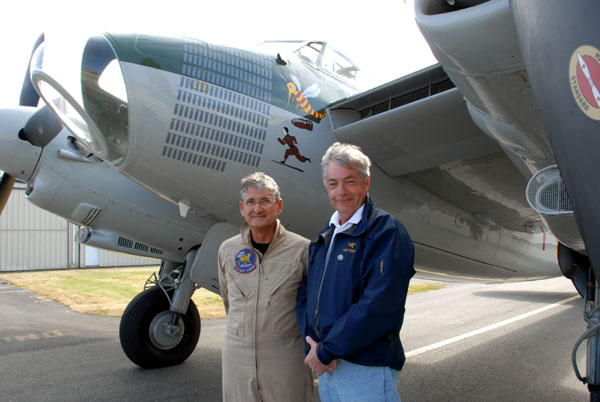
The author with pilot Steve Hinton after the last flight of the day. (Richard de Boer)
By the time they got back it was after 5 pm. Mike Ingram again surprised me by suggesting we could get some good shots if he towed the Mosquito back to the grass area near the museum and
away from the buildings and modern airplanes. I wasn't going to say no to that one. Mel, his son Graham, Mike, Kim Ingram and April all took turns posing with the Mosquito and sharing in
the moment. They clowned: I smiled and clicked.

Documentary film maker April Butler and Mike Ingram celebrate two successful flights on Wednesday. CF-HMJs' final flight the next day delivered it to her owner in Vancouver. (Richard de Boer)
We tucked her away for the night and I started to say my goodbyes to people. The plan was to deliver the Mosquito to its owner in Vancouver the next day, but I had a flight back to Calgary
that evening. 'If you have time, we're headed to the pub' said Mel. I had time. We were six people around a table for four. It was all airplane talk after a good day's flying. I had to
go just as the second round appeared. 'I have a de Havilland twin to catch home, but sadly not a Mosquito' I told them as I shook hands and made my exit.
The next afternoon I got a three word text advising me that 'She's in Van'. That night when I got home there was a long voice mail from John Watt telling me all about the short but
memorable 18 minute flight from Vic to Van. 'We did one flyby on the runway' he told me. 'Lots of people watching'.
In the end it was a total of just five flights and less than four hours flying time. She was tucked into the owner's hangar next to his Spit XIVe. At present there are no plans to display
or to fly her. That's just the way it is.
It was hard to go back to the somewhat mundane work-a-day world after that. We were a small group who shared, each from our own perspective, in a rare event and we all had ring side seats
for it. Over the next few days we swapped a lot of pictures and video. I got more emails from Mel, April and Robert and more voice mails from John. It felt like a kind of bond and no one
wanted to let go.
When I was in England three years ago I toured the De Havilland Heritage Center and their three Mosquitoes with one of the world's leading authorities on the type, Ian Thirsk. I sent him
some pictures and emailed him last week to tell him I had finally joined the 'I've Seen One Fly' club. He understood and suggested that they sound as good as they look. Yes they do.
Richard de Boer
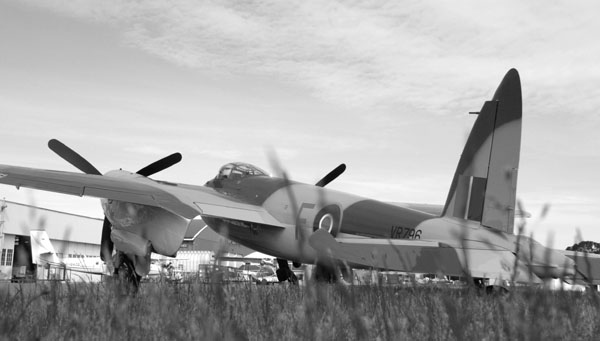
(Richard de Boer)